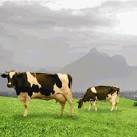Tim Hornibrook
New Zealand, due to its position as the world’s largest exporter of dairy products and favourable climatic conditions which results in a low cost, pasture based production system, understandably receives the majority of interest from those global investors interested in investing into the dairy.
For those investors enamored with the New Zealand dairy model but waiting on the sidelines looking for a cheaper entry point, a solution is less than a four hour flight away. Despite producing a small proportion of the world’s total milk supply, Australia is among the world’s major players in global dairy trade. Due to the warm climate and abundance of pasture lands, Australia is well suited for dairy farming. The deregulated dairy industry in Australia has enabled greater flexibility to adapt to changing global market dynamics and capitalise on growing import demand from Asia. Certainly the geographical proximity to these major import markets is a key reason for this competitiveness. Australia is also less exposed to high international grain prices due to a low-cost production model based on a high proportion of grass-feeding operations.
Within Australia, one region in particular stands out as an investment opportunity for dairy; Tasmania. Tasmania’s temperate climate, fertile soils, reliable rainfall and sunshine all ensure excellent growing conditions for lush pasture, underpinning the production of premium quality dairy products. Tasmanian dairy cows are housed outside all year round, grazing on grass and clover, while enjoying some of the cleanest air in the world. Tasmania is Australia‘s only island state and is separated from mainland Australia by Bass Strait. Tasmania is similar in size to Ireland and Sri Lanka, and half the size of Fujian Province in China. The dairy industry is the largest sector of Tasmania’s agricultural industry and a significant contributor to the Tasmanian economy.
Dairy in Tasmania offers a number of investment opportunities, including large-scale pasture-based milk production, specialty cheese manufacture and large-scale dairy commodity processing. Tasmanian dairy farmers benefit from a sustainable, low-cost, pasture-based production system, underpinned by reliable rainfall and increasing irrigation infrastructure. This translates to lower costs of production, considerable growth potential and a more reliable milk supply, when compared with many dairy districts both in Australia and internationally. The dairy industry is a priority sector with excellent growth prospects and the Tasmanian Government encourages investment in milk production (farming) and value adding within the state.
Tasmania is in a unique position within Australia for increased investment in dairy farming. The state’s expanding milk processing capacity offers opportunities and Tasmania’s climate and water availability ensure consistent and predictable production rates.
Climate
Tasmania has a temperate climate, fertile soils, reliable rainfall and plenty of sunshine, all of which ensure excellent growing conditions for lush pastures, underpinning the production of premium quality dairy products. Tasmanian dairy cows spend their time outside all year round, grazing on grass and clover whilst enjoying some of the cleanest air in the world.
Water availability
A key component of sustainable agriculture is the availability of reliable water supply for irrigation. Dairy stocking rates are directly linked to the availability of water and Tasmania’s most significant natural resource advantage is water. Tasmania has 12 per cent of Australia’s total water resource on less than one per cent of Australia’s total land area, and its average annual water run-off is almost twice that of the Murray Darling Basin in South Eastern Australia. Tasmania does not have the water supply constraints experienced in other parts of Australia and much of the world. An ongoing priority in Tasmania is the completion of major irrigation schemes, with the potential to double the water available for irrigation. The Australian and Tasmanian Governments have committed $220 million to develop irrigation schemes with at least 95 per cent reliability of water supply, in partnership with local communities around the state.
Farm irrigation
Tasmanian dairy farmers are increasingly using irrigation to supplement rainfall and maintain pasture production through summer and early autumn. Mostly this is based on farm schemes utilising winter storage or direct take from rivers and, in some areas, groundwater also contributes to the total supply. Irrigation water requirements Irrigation water requirements depend on soil type, climate, soil fertility and pasture species. The estimated annual irrigation requirements for wellmanaged perennial ryegrass dairy pastures are shown in the table above. Irrigation of well-managed dairy pasture with high soil fertility is likely to increase pasture utilisation by three to four tonnes of drymatter (tDM) per hectare per year, and this will typically require around four megalitres per hectare per year of water to be applied.
Land affordability
Tasmania has traditionally had lower land prices than comparable dairy areas in Victoria on the mainland of Australia and New Zealand.
There is also the potential for conversion into new dairy farms. Potential conversion farms include larger-scale beef or cropping farms in the higher rainfall areas and lower priced properties in the lower-rainfall areas that have access to a plentiful supply of irrigation water.
Biosecurity
As an island state, Tasmania has a clear biosecurity advantage. Tasmania’s biosecurity system is at the very core of the Tasmanian brand, as its natural environmental values and quality produce rely upon the state’s relative freedom from pests, diseases and weeds. The state is free of foot and mouth disease and bovine spongiform encephalopathy (BSE).
Government support
The Tasmanian Government is putting the state’s primary industries on the path to achieving a tenfold increase in the value of the sector by 2050. It recognises that the development of the dairy industry is important to the economic future of Tasmania and encourages potential investors to investigate the benefits of dairy production and value adding in the state.
The Tasmanian brand
Geographical isolation, a pristine environment, along with an ideal climate means that Tasmania has the opportunity to build a strong premium brand for its agricultural produce.
Tim Hornibrook

